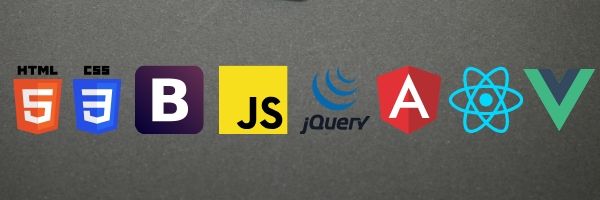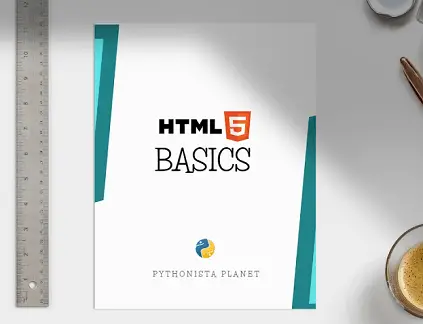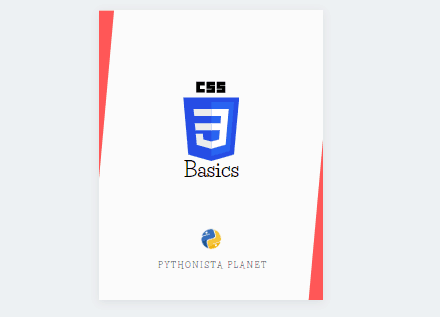Do you want to become a front-end web developer? Great! You are at the right place. In this article, I’ll share my thoughts on how to become a front-end web developer.
Anyone can learn web development and monetize their skills. But, there are plenty of things to learn in web development and it can be overwhelming for beginners. In this article, I’ll give you a roadmap so that you don’t need to waste your time figuring out what to learn next.
Let’s dive right in.
What Does A Front End Developer Do?
The web developer writes the necessary code for applications and websites, works on customization and implementation of functions needed to perform operations and activities.
The front-end developer is the programmer who takes care of the user interface of a website and its design.
When creating websites or applications, he uses HTML (for content), CSS, Bootstrap (for design), and JavaScript language and its frameworks such as Angular, React, or Vue, so that the user can see and interact with them.

Its challenge is to make the user experience fast and intuitive, allowing them to receive information in an easy-to-read format.
Not an easy task, since today, we have many devices available to connect.
In fact, the front-end developer has to operate in such a way that the site he has created has excellent performance, whether it’s viewed from a computer, tablet, or smartphone (which is called responsive web designing).
It must also take into account the different browsers from which a user accesses and the various operating systems.
How To Become A Front End Web Developer?
The first step to becoming a front-end web developer is to learn the necessary languages. You have to start from the basics. Start with HTML and CSS and then move on to JavaScript.
To understand front-end web development easily, let’s consider HTML, CSS, and JS as different aspects of a human body. In this analogy, HTML is the skeleton that defines the structure, JavaScript is the nervous system that controls the actions, and CSS is the body’s accessories that enhance the look of a person.

Let’s look at each of these technologies in detail.
HTML
This language is the structural component of a website. Basically, the HTML language consists of linked documents with which the user can interact. With this, the programmer defines the content of his site and the structure.
HTML (stands for HyperText Markup Language) is a language used for creating web pages. A markup language uses tags to identify content.
The structure of an HTML document is like that of a sandwich, containing opening and closing tags, and everything in between them.
If you want to learn HTML, I’ve prepared an HTML Basics Guide for beginners. You can download that from the below link. There are a lot of tutorials available online as well.
You can also check this HTML documentation. It is very easy to learn this language, and it doesn’t require much logic.

CSS
Just by learning HTML, you can create a website, but HTML alone won’t make the website perfect.
The aesthetics of a website, however, must also be taken care of. This is what CSS (stands for Cascading Style Sheets) is for. You need to learn CSS to design your website. CSS provides property modifiers that give color, font, and position to our content.
CSS is also a pretty simple language, and you can pick it up very quickly. CSS allows you to specifically style the HTML elements.
The main advantage of using CSS along with HTML is that it allows you to separate style from the actual content of the website. It is always better to store it in a separate CSS file, rather than storing it in the HTML file itself.
If you want to learn CSS, I’ve prepared a beginner’s guide to CSS, which you can download from the below link.
Check out the CSS documentation from MDN to learn more.

Bootstrap
There are also CSS frameworks (the most famous being Bootstrap), and they give you a starting point for faster programming.
Bootstrap is a free and open-source CSS framework directed at responsive, mobile-first front-end web development.
Bootstrap makes front-end web development faster and easier. Several classes and codes are predefined already in Bootstrap, and we can use them directly.
Since most CSS starts with the same elements for each project, a framework that defines much of the initial structure is handy.
Check out the official Bootstrap documentation to learn more.
JavaScript
Once the content is created and visually more appealing, the interaction with the user remains to be established. JavaScript is the language that allows the user to have a response after performing an action such as a simple mouse click.
If you want to become a front-end web developer, you must learn JavaScript. JavaScript has evolved a lot, and now it has become the go-to choice for web developers. With the emergence of frameworks such as Node.js, it is even used in the back-end as well.
Check out the Javascript documentation from MDN to learn more.
jQuery
JQuery is a JavaScript library. A series of plugins and extensions that simplify and speed up programming with JavaScript.
Instead of programming everything from the beginning, jQuery allows you to add ready-made elements to your projects and customize them the way you want.
You can use jQuery for counters, autocomplete forms, and even automatically resize tables.
Check out the official website of jQuery to learn more about it.
Front End Javascript Frameworks
JavaScript frameworks (including AngularJS, VueJS, Backbone, Ember, and ReactJS) provide you with ready-made structures to add dynamism, effects, asynchronous interactions, and more, often in very few lines of code.
Angular JS
Angular is a popular open-source front-end web framework mainly maintained by Google. It is a structural framework for dynamic web apps. It can reduce the code you write while making your site look awesome.
Angular lets you use HTML as your template language and lets you extend the syntax of HTML to express the components of your application clearly and succinctly.
There are different types of frameworks to suit different needs, and they speed up development considerably by giving you a starting point.
They can be used in combination with libraries like jQuery. In many work requests, knowledge of them is required because knowing how to use them dramatically reduces work time and optimizes the final result.
Check out this documentation to learn Angular in detail.
React JS
React is a JavaScript library maintained mainly by Facebook. It can be pretty helpful for building user interfaces, particularly for single-page applications. React allows us to create reusable UI components as well.
It can make the user interface of the web apps rich and engaging with minimal coding.
In the old days, developers were using pure Javascript to build the user interfaces, or JQuery, which is a less UI-focused library. That meant more development time and bugs. React framework was introduced to solve this problem.
Later, React Native was introduced, combining React with native platform capabilities, which became a popular mobile application development framework.
Check out this official documentation to learn more about React.
Vue JS
Vue is a JavaScript framework created by Evan You, for building user interfaces and single-page applications. Similar to the other JS frameworks, Vue.js helps split the logic of a webpage up into reusable components.
Vue is considered a comparatively easier framework to learn. It is a view-oriented framework. It can help you create smooth web applications that deal with complex data.
Check out this official documentation to learn Vue.js in depth.
Pick any one of these three frameworks and become good at it.
Self Learning vs Certifications
There are basically two ways to learn these languages. You either learn on your own, or you enroll in a degree course.
Let’s start with the second option available, the degree course. This choice is undoubtedly better, more complete, and safer than the first one, even if it also has some limitations.
The degree in computer science offers an extensive background of knowledge but focuses little on the practice of programming languages. Consequently, it is not an optimal solution for those who want to become front-end developers.
The first option available, and perhaps the most considered one, is to train yourself. This means that you don’t need anything other than a PC with an Internet connection.
The web, in fact, is rich enough in texts, courses, and video courses to enable a person to learn a programming language.
You can find many courses on Udemy, Coursera, and for free on YouTube.
However, before embarking on this adventure, you should consider all the pros and cons.
First of all, although the online material is not lacking, you have to look at its completeness and specificity.
Finally, it should be emphasized that, although behind a linear and complete training, the self-taught course does not issue any certification regarding the skills learned.
You can avoid this by enrolling in online courses with recognized certifications if needed.
Content Management Systems
A tip. If you want to become a front-end web developer, having the knowledge of CMS (Content Management System) would also help sometimes.
The most widespread CMS in the world is WordPress, which is a kind of behind-the-scenes for millions of websites, and almost 60% of sites using a CMS use WordPress.
Other CMSs include Joomla, Drupal, and Magento. Although it is advisable to specialize in WordPress, also learning how to use different platforms can allow you to dedicate yourself to a particular niche and work with companies that use them.
Develop The Problem-solving Skill
If there’s one thing every front-end web developer should have, it’s the “problem-solving” skill.
What does that mean? It means that you will need to be able to distinguish which is the best way to implement a project, how to fix bugs, and to make the front-end work with the code executed on the backend.
An excellent front-end developer sees unexpected problems that arise as a puzzle to solve, and not as a disaster.
For example, you may make a fully functional front end. Still, when you submit it to the back-end developers to integrate it with the content management system, suddenly, half of its functionality is blocked!
Tragedy? No, it’s a challenge! Even an experienced front-end developer anticipates these problems and prevents them from the beginning. Programming is all about problem-solving.
Final Thoughts
Becoming a front-end web developer is not a big hurdle. If you learn the required languages and build some cool projects with them, you’ll become good at your skills. Build as many projects as you can. Once you think that you’re ready, you can apply for jobs.
I hope this article was helpful to you. Let me know if you have any doubts in the comments section.
Check out the article that I wrote on Best Udemy Courses For Front End Web Development.
Happy coding!
5 thoughts on “How to Become a Front-end Web Developer”
Leave a Reply
Recent Posts
Modular programming is a software design technique that emphasizes separating the functionality of a program into independent, interchangeable modules. In this tutorial, let's understand what modular...
While Flask provides the essentials to get a web application up and running, it doesn't force anything upon the developer. This means that many features aren't included in the core framework....


very helpful.
I’m happy to help you 🙂
Thanks for all those articles, they are great!
You’re welcome. Glad that the articles helped you.
Thanks for all those articles, they are great!